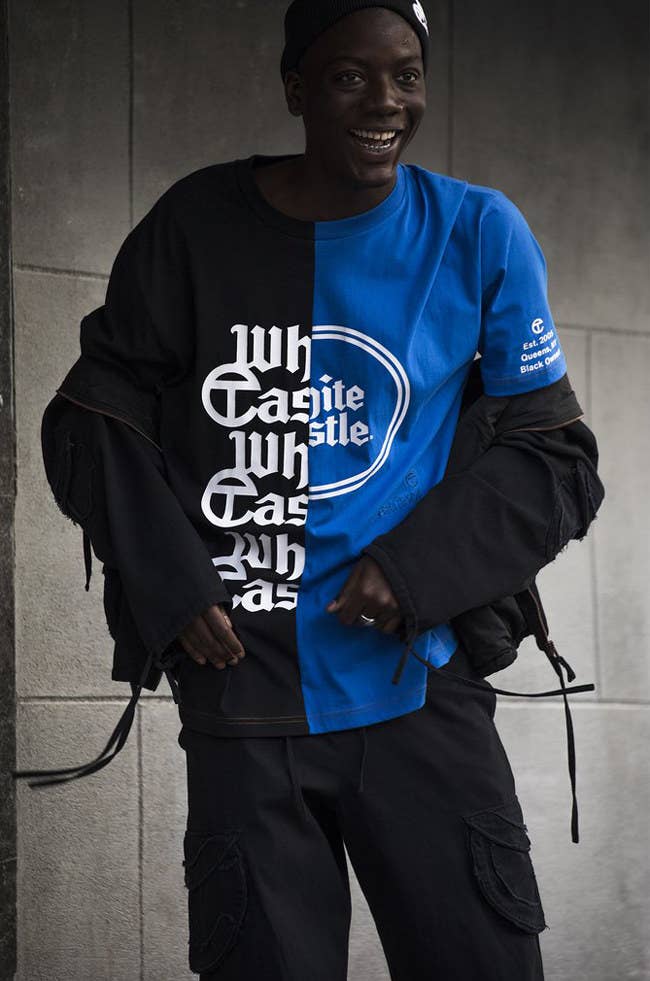Common Fabric Types Used in Branded Clothing and What They Mean
Common Fabric Types Used in Branded Clothing and What They Mean
Blog Article
The Importance of Sustainable Clothing: How It Affects the Environment and Your Storage room
Sustainable garments is increasingly acknowledged for its vital function in reducing the environmental effect of the fast fashion business. By concentrating on eco-friendly products and moral manufacturing methods, it deals with pressing environmental problems. This change not only benefits the world but additionally affects consumer choices, resulting in an extra thoughtful technique to wardrobe monitoring. Understanding these dynamics raises vital questions regarding fashion's future and personal obligation in forming it.
The Environmental Footprint of Rapid Style

Benefits of Lasting Materials
Lasting materials supply considerable benefits, particularly with green textile options that reduce ecological harm. These materials additionally demonstrate resilience and longevity, lowering the demand for frequent substitutes. Because of this, they add to a more lasting garment industry and promote liable customer behavior.
Eco-Friendly Textile Options
While the style sector has long been connected with quick trends and environmental harm, the surge of environmentally friendly fabric choices presents a transformative opportunity. Sustainable products such as natural cotton, hemp, and Tencel have acquired popularity as a result of their reduced ecological impact. These materials are typically generated without damaging chemicals and need less water, decreasing their carbon footprint - Branded Clothing. Furthermore, lots of environment-friendly materials are biodegradable, adding to a circular economic climate by reducing waste. Picking lasting products not just sustains eco liable practices yet also promotes healthier communities. As customers become extra familiar with their buying power, the demand for eco-friendly fabrics motivates brand names to introduce and embrace more sustainable manufacturing techniques, eventually benefiting the world and future generations
Durability and Durability Advantages
Many customers are increasingly acknowledging the toughness and long life advantages of sustainable materials in their garments choices. Unlike standard textiles, lasting products such as organic cotton, hemp, and recycled polyester are crafted to endure wear and tear, resulting in garments that last longer. This minimized regularity of substitute not only conserves customers money over time yet likewise lessens waste produced by rapid fashion. Furthermore, lasting clothes usually utilizes environment-friendly production techniques that boost material strength, adding to a reduction in the overall carbon impact. By purchasing resilient garments, consumers can grow a more lasting closet while delighting in top quality pieces that preserve their aesthetic and performance gradually. Longevity and durability stand as crucial benefits of selecting sustainable materials.
Reducing Waste Through Lasting Practices
Decreasing waste in the apparel industry can be accomplished with innovative methods such as upcycling and repurposing materials. In addition, adopting minimalist wardrobe techniques motivates consumers to prioritize high quality over amount, ultimately lowering clothes usage. With each other, these approaches contribute considerably to a more lasting garments version.
Upcycling and Repurposing Products
Upcycling and repurposing products have actually arised as cutting-edge approaches in the apparel industry, changing thrown out textiles right into beneficial brand-new products. This technique not only minimizes waste yet also urges imagination and individuality in apparel design. By taking old garments and materials, developers can produce one-of-a-kind pieces that mirror individual style while decreasing the need for brand-new resources. In addition, upcycling typically requires less power and water compared to conventional production procedures, significantly reducing the environmental footprint of fashion. As consumers come to be much more familiar with sustainability, the popularity of upcycled apparel remains to rise, advertising a circular economic situation. Inevitably, these methods contribute to an extra lasting future, where fashion prioritizes environmental wellness over fast production and usage.

Minimalist Closet Techniques
As people progressively look for to reduce their ecological effect, embracing minimal closet strategies has actually gotten traction as an effective method to sustainable fashion. These techniques highlight quality over quantity, motivating customers to curate a smaller collection of functional, resilient garments. By concentrating on timeless items that can be mixed and matched, individuals can reduce the regularity of acquisitions and ultimately reduce waste.Additionally, minimalism promotes conscious consumption, prompting customers to review the moral and ecological effects of their selections. This technique not only cultivates a more lasting lifestyle yet likewise simplifies day-to-day decision-making pertaining to clothes. As people welcome minimalist principles, they add to a fashion society that values sustainability and accountable consumerism, ultimately leading to a much more eco-conscious society.
The Duty of Moral Labor in Sustainable Style
While numerous customers are increasingly mindful of the ecological consequences of their apparel selections, the importance of moral labor techniques in sustainable style can not be neglected. Ethical labor click reference incorporates reasonable earnings, safe working problems, and respect for employees' rights, developing the foundation of responsible style manufacturing. Brands that focus on ethical labor not only boost neighborhoods yet also set a standard for responsibility in the industry.Moreover, the combination of moral methods promotes openness, making it possible for consumers to make educated selections about their acquisitions. This technique contrasts sharply with quick style's unscrupulous labor models, why not try this out which usually prioritize profit over individuals. By supporting business committed to ethical labor, consumers add to a system that values human self-respect along with ecological sustainability. Subsequently, ethical labor is not merely an add-on; it is crucial to the broader mission of sustainable fashion, making sure that the mission for eco-friendliness does not come with the expenditure of human legal rights.
The Effect of Sustainable Clothing on Carbon Emissions
Lasting apparel has the possible to substantially minimize carbon exhausts related to the fashion market. Traditional garment manufacturing adds notably to greenhouse gas emissions, largely because of energy-intensive manufacturing processes and using non-renewable sources. In comparison, lasting fashion focuses on eco-friendly products, such as organic cotton or recycled fibers, which often require much less energy to produce.Moreover, lasting brands often tend to embrace more reliable manufacturing practices, decreasing waste and reducing general emissions. By prioritizing longevity and classic style, lasting apparel motivates customers to get much less often, further lowering the carbon impact related to overconsumption.Additionally, lots of sustainable brands are committed to openness in their supply chains, allowing customers to make educated choices that line up with their worths. Inevitably, changing towards sustainable clothing can result in a substantial reduction in carbon emissions, adding to a much healthier planet and an extra lasting future for the fashion business.
Sustaining Neighborhood Economies With Lasting Options
The change towards lasting clothes not just addresses ecological problems yet additionally considerably benefits regional economic situations. By choosing sustainable fashion, consumers usually support small organizations and local artisans, improving area strength. These enterprises generally run on a smaller sized scale, prioritizing craftsmanship and ethical methods over mass production.Investing in locally made sustainable garments promotes work production and boosts economic development within areas. As customers become much more familiar with the environmental influence of their acquisitions, they significantly seek items that reflect their worths. This need urges neighborhood manufacturers to adopt sustainable practices, contributing to a circular economy.Moreover, supporting neighborhood organizations lowers transport discharges, lining up with eco-conscious consumer behavior. The interconnectedness of sustainable clothing and neighborhood economic situations highlights the vital function that private selections play in advertising both environmental and economic health. By promoting these regional connections, areas can prosper while also working in the direction of a more lasting future.
Changing Your Closet: Tips for a Sustainable Closet
As individuals seek to lower their ecological effect, transforming a storage room right into a lasting wardrobe ends up being an essential action. One visite site efficient method is to assess existing clothing, maintaining only items that are worn routinely and that align with sustainability objectives. Prioritizing high quality over amount is vital; purchasing sturdy items from green brand names can substantially lower waste.Additionally, integrating used things can breathe brand-new life into a wardrobe while decreasing ecological damages. Organizing clothing swaps with close friends or contributing extra items can further advertise sustainability.When shopping, people need to seek products that are natural, recycled, or biodegradable, and prevent quick style retailers - Branded Clothing. Lastly, exercising conscious consumption by attentively considering each purchase can contribute to a much more lasting way of living. By implementing these tips, one can create a wardrobe that shows personal style while sustaining ecological stewardship
Often Asked Inquiries
Just How Can I Recognize Sustainable Clothing Brands?
To identify sustainable clothes brand names, one should research products utilized, look for qualifications like Fair Profession, and examine the brand name's openness regarding their production procedures, labor techniques, and ecological effect, making certain eco-friendly and moral techniques are focused on.
What Are the Prices Linked With Lasting Style?
The expenses connected with lasting style can differ substantially. Greater manufacturing expenses, ethical sourcing, and eco-friendly materials typically result in enhanced list prices, which might deter some customers while interesting ecologically aware buyers.
Can Lasting Clothes Be Stylish and Fashionable?
Lasting apparel can without a doubt be stylish and elegant. Designers increasingly focus on innovative products and ethical manufacturing techniques, proving that style and sustainability can coexist. Consumers currently have diverse alternatives that blend looks with environmental awareness.
How Does Laundering Clothing Affect Their Sustainability?
Washing garments considerably effects sustainability by consuming water and energy, contributing to air pollution, and creating microplastic release. Frequent cleaning can break down fabrics, shortening their lifespan and increasing the need for replacements, inevitably aggravating environmental issues.
What Is the Life Expectancy of Sustainable Apparel Compared to Rapid Style?
The life expectancy of sustainable clothes typically surpasses that of fast style items, typically lasting several years due to high quality materials and workmanship. In comparison, fast fashion garments might break down swiftly, demanding even more regular substitutes. Lasting garments is increasingly identified for its crucial duty in reducing the ecological effect of the quick fashion market. While lots of customers are progressively conscious of the environmental repercussions of their garments options, the importance of honest labor practices in sustainable style can not be forgotten. Branded Clothing. Lasting garments has the prospective to greatly decrease carbon discharges connected with the style market. In comparison, lasting style concentrates on eco-friendly materials, such as organic cotton or recycled fibers, which commonly require less power to produce.Moreover, sustainable brand names often tend to take on a lot more effective manufacturing techniques, decreasing waste and decreasing total discharges. By prioritizing resilience and timeless style, lasting clothes urges customers to purchase much less often, more minimizing the carbon footprint associated with overconsumption.Additionally, lots of sustainable brand names are committed to openness in their supply chains, allowing customers to make educated options that line up with their values
Report this page